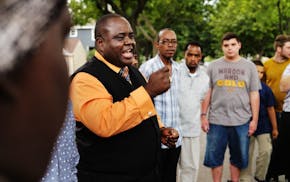Carving knives in hand, a group of students in a South High School classroom watched their instructors demonstrate various cuts on a piece of cedar wood.
While for most students it was the first class in a winter woodcarving session offered through Minneapolis Community Education, it marked Robie Ryan's third time participating in the course. Ryan said she enjoyed doing something with her hands and learning from the instructors, who are fun and engaging. But the craft itself wasn't why Ryan had taken a chance on the class.
"I was like, let me do the community ed thing and see if I can meet people," said Ryan, 29, as she worked on a wooden bird. "It's social, they teach us something, but for most of the two hours, I'm sitting, I'm carving, I'm chatting."
Interest in community education classes in Minnesota is growing among younger participants as more people seek out third spaces — gathering places beyond work and home — and opportunities to connect with their neighbors.
Community education began in Minnesota in 1969 with the formation of the Minneapolis program. The programming was intended to "make maximum use of the public schools of Minnesota by the community," or to utilize school buildings that would otherwise be empty in summer months and after dark.
Across the state, Minnesota has seen a notable increase in class registrations among younger adults in their 20s and 30s who are seeking personal development or recreational opportunities, said Matt Dickhausen, executive director of the Minnesota Community Education Association.
Upstairs from the wood-carvers, a group of students with clay-stained hands sat behind pottery wheels, shaping — or attempting to — their first clay projects.
For student Jamie Tan, community ed is an opportunity to to connect with new people — and old friends. She signed up for the pottery class with a high school friend, Erika Storvick, who sat beside her at her wheel.
"Now I get to hang out with Jamie every Tuesday," Storvick said.
This winter, community ed programs have seen a 28% increase in participants under the age of 30. The average age of participants has fallen slightly, from 46 last year to 43 this winter, according to the Minneapolis community ed program.
Demand was so high this year that the registration software briefly crashed. Among the 455 unique classes Minneapolis offered across school buildings this winter, the quickest classes to fill up were pottery, mending and herb gardening, said Andrew Gramm, Minneapolis Community Education program specialist.
Woodcarving was a hot ticket too, said Ryan, who had a friend or two miss out on the class this season.
"I'm waking up, getting my computer ready at 8:45 a.m. for registration," Ryan said. "It's intense."
Loneliness is a public health issue, Gramm said, pointing to the U.S. surgeon general's 2023 findings that social disconnection harms both individual and societal health. Strengthened social bonding pays dividends across age groups in community ed classes — with students saying that classes have helped them feel connected as transplants or rebuild routine after the loss of a spouse, Gramm said.
"There are a lot of tools and a lot of pressures that disconnect us from people and drives us apart from getting to know people," Gramm said. "Our competition for these classes isn't a program somewhere else. It's people watching Netflix at home."
In St. Paul, 15% of last year's participants were under 30 — a percentage certain to be surpassed this year, said Katy Mommaerts, community programs supervisor at Saint Paul Public Schools. In the previous year, just 10% of participants were younger than 30.
Across every age demographic, St. Paul community education has seen higher than average registration numbers each year since the end of the pandemic, Mommaerts said.
"People realized how much they missed it, so they've been coming back even more, wanting to get out in the community, to take classes with people that aren't necessarily within their core group of friends," Mommaerts said.
Of the 374 classes offered in St. Paul this winter, pickleball and art classes are most in demand among younger participants, she said. To attract younger adults, the St. Paul program is partnering with breweries and other off-site facilities for activities like goat yoga or glass bead making at Chicago Fire Arts.
Organizers see surprising popularity in new classes that correlate with internet trends, like junk journaling or a ballet partnership with a local dance studio, Mommaerts said.
For those looking to build connections, Mommaerts recommends classes with multiple sessions rather than one-offs. Active classes like fitness, acting or cooking lend themselves to the most conversation.
"If you're going to take a community ed class, look for a topic you're curious about," she said. "Because if you go into a class where you have some interest in the topic already, you're going to be in a class with a lot of other people who have that same curiosity."
Ryan, a transplant, said she set an intention a year ago to put herself out there more. Now she has a group chat with friends from that first woodcarving class.
"It's low commitment, but it can be really high reward," Ryan said.
Worried about the future? We predict you'll read this story about a high-profile St. Paul astrologer

Head of violence interruption program in Twin Cities charged with stealing $150,000 in employee wages
Police identify victim of homicide on St. Paul's West Side
